George M. Cohan In America's Theater | home
Stageography | What's New | George Washington, Jr. | The Merry Malones | Broadway Jones | 45 Minutes From Broadway | About Me | The Little Millionaire | Little Nellie Kelly | The Tavern | Seven Keys To Baldpate | Ah, Wilderness! | Get Rich Quick Wallingford | The Royal Vagabond | Discography & Filmography | Early years: 1878-1900 | Broadway Rise: 1900-1909 | Broadway Emperor: 1910-1919 | Decline & Fall: 1920-1929 | Little Johnny Jones | I'd Rather Be Right | Broadway Legend: 1930-1978 | Mailbag/Contact Me | Related Links | Articles & Thoughts | The Yankee Prince
Broadway Rise: 1900-1909
The first year of the new century was the last year the Four Cohans played
vaudeville. They were on the Hyde and Behman circuit, commanding $1,000
a week salary (an unbelievable sum in 1900). George was now dictating the
terms of the contract - demanding top billing, lengths of engagements and
what traveling routes were best suited for their needs. He also demanded
from Behman that he agree to produce a full length version of one of his sketches
in the near future. Behman agreed.
On the road they traveled, and many times during the trip there were arguments
and tantrums from George and Ethel (she never backed down from George).
Things became even more difficult for the performing family when Ethel became
pregnant. On August 26, 1900, Ethel gave birth to their daughter Georgette.
The family finished out their contract on the Hyde & Behman circuit and George
now set his sights on bringing an expanded versions of "The Governor's Son"
to the legitimate stage.
Just as "The Governor's Son" was about to premiere, The White Rats (a
union for vaudeville actors), called a strike against the inhumane conditions
they were forced to endure by the vaudeville managers. Since a good majority
of the actors in George's show were vaudeville actors, his theatrical debut was
in serious jeopardy. Behman also demanded that Cohan either perform or forget
the idea of his own show. Cohan, furious over the position he was placed in,
went searching for a loophole, and found it. The White Rats had given sanctity
to Weber & Fields' Music Hall because they considered the show a part of the
legitimate theater. Cohan argued that his show, was completely out of the
vaudeville status, and also should be exempt from a strike. The White Rats
debated (Lou Behman was one of the prime targets they were striking
against), for fear that they would lose ground in the strike. George soon got
word that the union considered his show outside the boundaries of the strike.
On February 11, 1901 it debuted in Hartford, CT. Two of the songs went over
well with the audience (both were performed by George & Josie). But when
"The Governor's Son" opened on Broadway (February 25,1901) it received
less than desirable reviews.
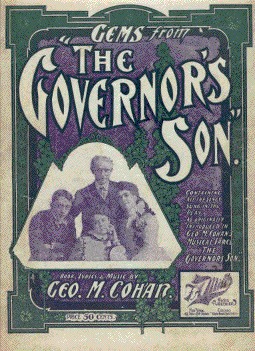
Sheet Music Cover
Regardless of the reviews, George M. Cohan had found his niche. Musical comedy
would be his trademark for the next 38 years. Of the songs, only one can easily
still be heard. "Push Me Along In My Pushcart" was brought back to life by the
original cast of "George M!"
In an interview (circa 1904) George relays his feelings toward vaudeville.
"As I told my father the other day, the only thing I'm proud of about vaudeville
is that I got out of it. The houses are not all Orpheums and Keith - not by a long
way. There are only a few good houses and the others I wouldn't like to talk
about - right out loud."

Sheet Music with Josie Cohan
Yet, his vaudeville experiences would be the ones he would cherish to his final
days. When his friends would gather to hear him tell of his show business
adventures, Cohan would always refer to his early days in vaudeville as the
ones where he was happiest.
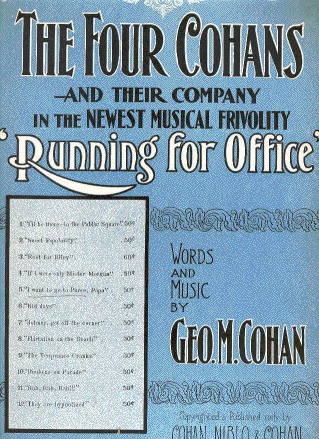
Sheet Music Cover for "Running For Office" 1903
Note the Publishing Company of Cohan, Niblo, & Cohan
at the bottom
The Cohan family continued to expand in the next year. Josie had been courted
by a young comedian named Fred Niblo, and after their marriage in June
1901, Fred became partners with George & Jerry (George gained control of
his production after Lou Behman died in 1901). For the next two years they
made money by touring the country in "The Governor's Son. By 1903, they
returned to New York with a second effort entitled: "Running For Office." This too,
was an expanded version of a vaudeville sketch performed by The Four Cohans,
and was given a luke warm reception by New York. George and family realized
that the road held riches for them (even if New York didn't) and remained
optimistic as they toured the country.
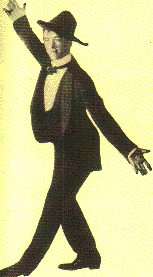
A posed publictiy still
from "Running For Office"
However, just before they went out on the road, George had struck a deal with
Theatrical Syndicate giant, Abraham Erlanger. Erlanger was to most, the most
vile man in all the theater. No one was hated or despised as much as Abe Erlanger,
not even the Shuberts (who would run a close second). Yet, Erlanger liked Cohan,
and trusted George's judgment completely. In "Mother Goose," (the show was
created in the wake of "The Wizard Of Oz," and "Babes In Toyland") Cohan provided
him with four new songs. Two of them, went on to become Cohan classics
("I Want To Hear A Yankee Doodle Tune" and "Always Leave Them Laughing").
But the tension that began when Ethel joined the Four Cohans, escalated and
peaked during the road trip of "Running For Office." In particular, Josie had
had enough (she never did get along with Ethel, and Ethel was always
competitive with Josie). The exact nature of their feud is not known. Josie and
Fred had made their own plans, and sensed it was time to leave. By August of
1904, Abraham Erlanger offered the couple parts in a new comedy he backed
called, "The Rogers Brothers in Paris," and with tears in her eyes Josie (with Fred)
left the Four Cohans. Later that year, "The Dramatic Mirror" reviewed her
performance in the Rogers Brother's Comedy...
"The one especially pleasing feature of the performance was the dainty charming
work of Josephine Cohan. Her song, "Society," in which she introduced the steps
that have placed her among the foremost dancers of the day, was done with
grace and charm irresistible. She radiated refinement...Fred Niblo, was made a
reputation as a monologist in vaudeville, had no opportunity to display his talent.
He looked the gentleman he is, however."
George M. suddenly found himself out of work, and his family split up. To
remedy the latter, George substituted Ethel for Josie, but fixing the former,
wouldn't happen until he had a chance meeting with a former cough-drop
salesman named, Sam Harris.
Sam Harris was born on Mulberry Street in lower Manhattan to a low income
family. As a boy, he did everything he could to help his family survive by
working as many odd jobs (selling newspapers, messenger, salesmen) as he
could. By the time he was introduced to Cohan in 1904, he was managing boxer
Terry McGovern, and had co-produced several shows on the Bowery (one of
his discoveries was Mary Pickford). Harris complimented Cohan perfectly.
In addition to an undying love of theater, they both enjoyed baseball, shared
the same sense of humor, and were shrewd about their business. Harris also
had an uncanny knack of being able to identify any scripting trouble their
production might have during rehearsal.
The team of Cohan and Harris would prosper and last until 1920.
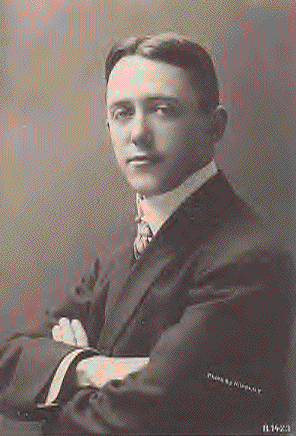
Postcard of George M. Cohan (circa 1906)
Over the next two years Cohan would perform in "Little Johnny Jones" and make
himself a household name. This was further solidified with his next effort "Forty-
Five Minutes From Broadway," that starred Fay Tempelton and Victor Moore. A
month later, he opened in "George Washington Jr." in which he once again
starred himself and his family.

George M., Victor Moore, & Sam Harris
on the set of "45 Minutes From Broadway"
It looked as if George M. Cohan was more than a passing fancy to Broadway
in 1906. But with all his professional success, his personal life was in chaos.
In late December of 1906, Ethel Levey walked out on the cast of "George
Washington Jr." in Cleveland. Mutually, George was through with Ethel. He
had fallen in love with the chorus girl, Agnes Nolan, from "Little Johnny Jones,"
and was ready to marry her. He offered Ethel $100,000 for her interests in his
company, but she declined. She sued him for divorce on grounds of
unfaithfulness in February of 1907.

Ethel Levey
(circa 1900)
Afterwards, Ethel continued her performing career in vaudeville with songs like
"The Welcome Mat Ain't Meant For Me" (1907), "An A Little Bit More" (1907),
"The San Antonio Song" (1908), and Broadway shows like "Nearly A Hero"
(1908), "Gaby" (1911), with the popular songs "I Beg Your Pardon Dear Old
Broadway," and "Go Easy Mabel" (1912). She left New York and engaged
a successful stage career in London before returning once again to New York
to appear in "Marinka" (1945) on Broadway . She lived until 1955.
To make matters even worse for George, his first attempt at a nonmusical,
("Popularity") was a complete failure. Thomas Ross was the unlucky actor who
Cohan selected for the leading role. He would go on to have a successful
career on Broadway including being a member of the original cast of "Our
Town." However, the show did produce one thing that was successful, its theme
music, "Popularity." While not quite at the level of a Scott Joplin piece, the
music does showcase Cohan's abilities as a composer. There is a wonderful
fully orchestrated rendition of it in the soundtrack album of "George M!," and
(even when it's just a piano solo), its synchopated rhythms and life are still
strong today.

Sheet Music to "Popularity"
one of Cohan's few ragtime songs.
With Ethel now a part of his past, George was free to ask Agnes to marry him.
On June 29, 1907 they married. Agnes volunteered to retire from the stage. She
thought it was more important that her showman husband have a warm home
after a hard night at the theater.
Over the next four years, Cohan decided not to attempt writing any more
"straight" plays (non-musicals), but instead pursue what had made him a household
name: musicals. After reviving "The Governor's Son" (1906) the summer before,
he got the idea that he could rework "Running For Office," and give it a new name:
"The Honeymooners" (1907). The show featured some songs from "Running For
Office and new ones. Cohan lovingly dedicated "The Honeymooners" to his new
wife, Agnes.

Cohan in the revival of
"The Governor's Son"
Next, he wrote a sequel to "Forty-five Minutes From Broadway," entitled "The
Talk Of New York," and Sam acquired the services of Victor Moore once again
to reprise his role of Kid Burns. In his next show, "Fifty Miles From Boston,"
Cohan gave birth to another song that would become a standard in America's
catalogue: "Harrigan." The song was written for Edward Harrigan, member
of one of the most influential comedy teams of all time - Harrigan & Hart. Of
him Cohan wrote:
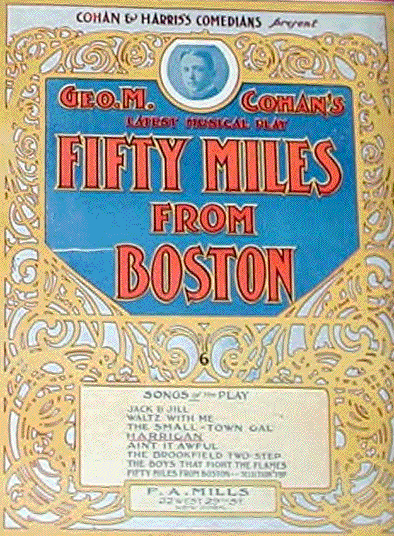
Sheet Music Cover for "Harrigan" (1907)
"Edward Harrigan was a fine artist, a great writer of human comedies and one
of the grandest men it has ever been my pleasure to meet. Hoyt could always
tickle the funny bone of the American theatergoer, but Harrigan turned the same
trick and got to the old heartstrings at the same time. Harrigan inspired me
when I applauded him from a gallery seat. Harrigan encouraged me when I
first met him in after years and told him of my ambitions. I live in hopes that
someday my name may mean half as much to the coming generation of
American playwrights as Harrigan's name has meant to me."
It is also of note that in 1911 Cohan chose a song from "50 Miles From Boston"
to record for RCA Victor entitled, "Small Town Gal."
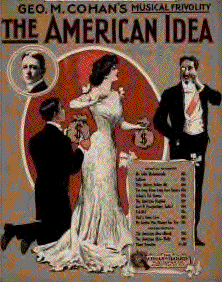
Sheet Music Cover (1908)
Cohan & Harris continued to thrive in the world of musical comedy. In 1908,
they reunited the Four Cohans in "The Yankee Prince," and later that season
opened "The American Idea" with Trixie Freganza. It was also the year that
Cohan and Harris became part of the same family when Sam married Alice
Nolan (Agnes' sister).
The following year, "The Cohan and Harris Minstrels" opened with a hit song
George had written in a one act sketch for the Friars club; "The Belle Of The
Barber's Ball." More a review than show with a plot, the cast featured George
"Honey Boy" Evans, and female impersonator Julian Eltinge.
On October 11, almost three years after "Popularity," George M. took his only
true failure, rewrote it, set new music to it, and called it "The Man Who Owns
Broadway." It's title song (like "Popularity's") helped boost the show's
success, and with a personality like Raymond Hitchcock in the lead, Cohan
& Harris knew they had a winning combination.
Winston Smith's "The Fortune Hunter" was the team's next production. After
a slow start, the show finally took off and catapulted its leading man John
Barrymore to stardom. Cohan & Harris knew that Barrymore's matinee style
stardom (much like his father's) was the main reason for the show's success.
They also knew of Barrymore's already alarming fondness of alcohol. On
April 30, 1910, Cohan & Harris insisted that John Barrymore sign an insurance
agreement for $50,000 a year pledging, "I am not now engaged to be married nor
do I contemplate marriage." It was great publicity.
Cohan & Harris were now the consummate showmen. They had become wealthy
beyond their expectations. Their credibility exceeded their wealth (most actors
knew that working in a Cohan & Harris production meant guaranteed pay, and
reasonable working conditions). But this was still the beginning. The next
decade would take them even higher.
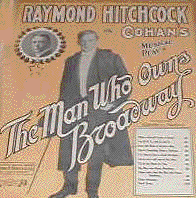
Sheet Music Cover for
"The Man Who Owns Broadway"